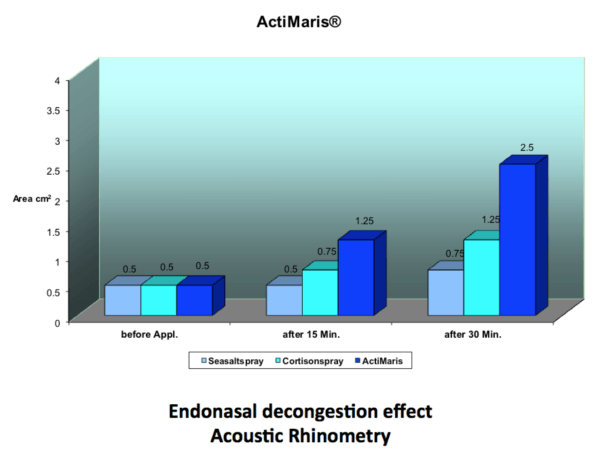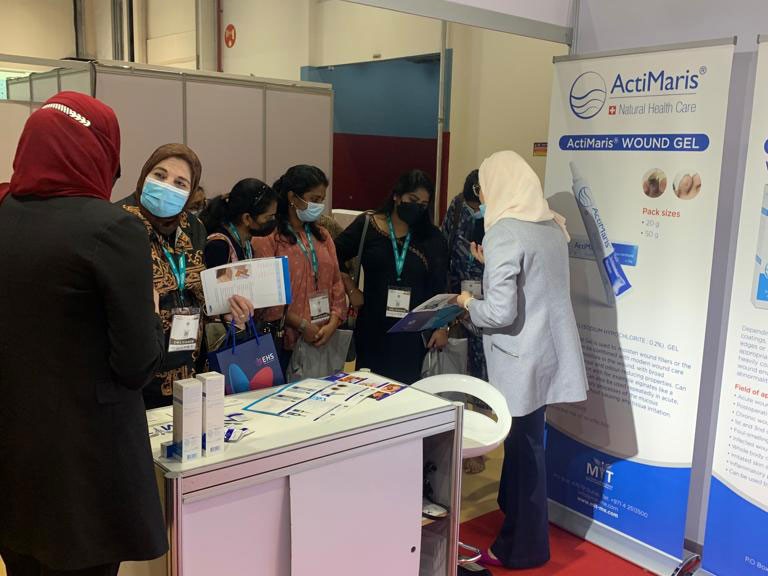ActiMaris hat sich gefreut aktiv am 6. Kongress der WUWHS 2022 (World Union of Wounds Healing Societes) teilgenommen zu haben, um unsere experimentellen und klinischen Erfahrungen mit führenden Experten im Bereich der Wundbehandlung zu teilen. In diesem Sinne waren wir auf dem Kongress mit drei Beiträgen vertreten, die das gesamte Spektrum unserer wissenschaftlichen Aktivitäten widerspiegeln.
An unserem kleinen Kongressstand durfen wir unsere wissenschaftlichen Erfahrungen mit den Besuchern teilen. Das interesse war sehr gross, was uns selbstverständlich sehr gefreut hat.
ActiMaris® Abstracts
ACTIMARIS® COMPLEX IN THE TREATMENT OF CHRONIC WOUNDS DIFFERENT ETIOLOGIES
A CASE STUDIES
Damir Marincic, MD
Quorum Medis Center, (St.Gallen, SWITZERLAND)
Background and Aims
There is a tight interrelationship of cellular, genetic and microenvironmental reactivity among wound healing, chronic fibrosis and cancer development, using complemental signaling pathway. Tumors are also known as the wounds that do not heal. Tumor tissue as that of many chronic wounds is hypoxic, acidic, and the cells of low energy. The chronic wounds need primary the creation of an optimal environment and functional signaling networks. To achieve this, the cells needs oxygen, energy, electron flow and correction of acidosis to proceed the cascades of the healing process.
Method
We traded three groups of patients with chronic wounds: leg ulcers, DFU and tumor ulcers in a case study series of 20 patients with Oxygen-ROS-Redox (ORR) complex and present here a case report of the patient with cancer ulcer on the neck, from the primary squamous cell carcinoma of oropharynx. While all wounds don’t healed with „standard“ therapy for at least 3 months, we continued the local therapy after 2 weeks of „wash out“ period in a form of modified cross-over design, with ORR complex liquid, followed by gel 2 times a day for 3 months.
Results
The primary end points of the study, were the time in weeks for resolution of inflammation, infection and complete wound closure. In the case of non-healing cancer neck wound from metastasis of the primary oropharynx carcinoma, the wound persisted for 6 months and healed after 7 weeks under local therapy with ORR complex without scar. These case is presented on 3 pictures.
Conclusions
Chronic wounds different etiologies needs for the proceeding of healing process oxygenation, redoxpotential, electron flow / microcurrent and physiological basic environment. All that can be achieved by local monotherapy with the ORR complex.
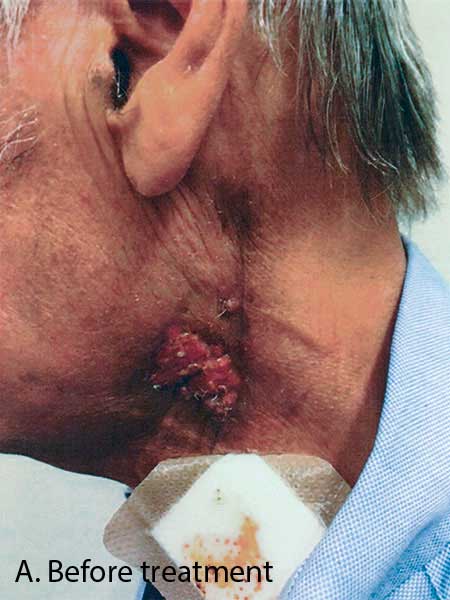
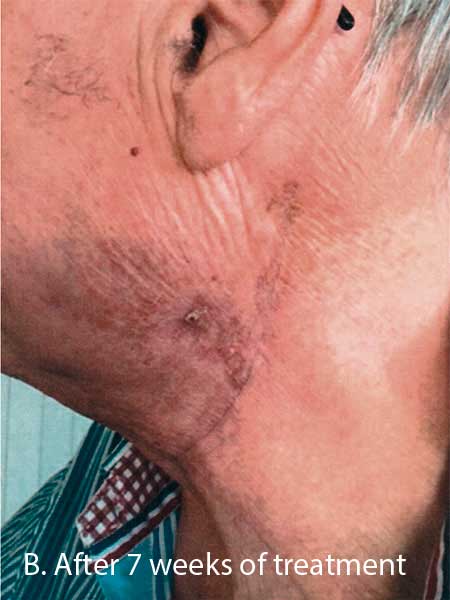
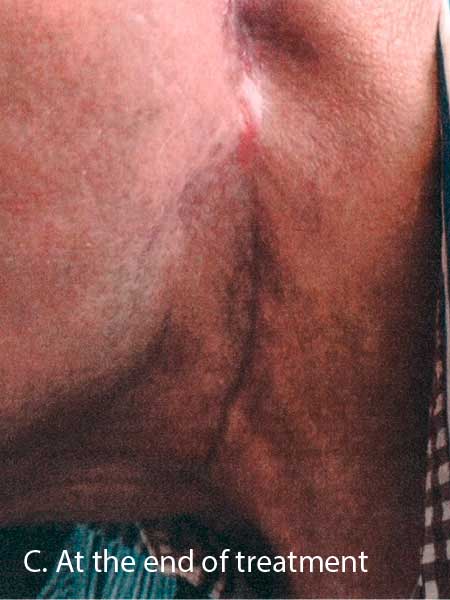
ACTIMARIS® COMPLEX IN THE LOCAL TREATMENT OF THE NON-HEALING WOUNDS
– NOT MORE THERAPY MAKE BETTER, BUT APPROPRIATE THERAPY DO
Damir Marincic, MD
Quorum Medis Center, (St.Gallen, SWITZERLAND)
Background and Aims
The aim of this report is to present a modern therapeutic agent for the local therapy of non-healing wounds, otherwise stubborn for the “standard” therapeutically modalities. The composition of this Oxygen-ROS-Redox (ORR) complex, in liquid and gel form is multifaceted with it’s multitarget actions, as antimicrobial, energycharger and supporter of signaling pathways of the wounds healing processes.
Method
Our therapy concept/method has 4 aspects and has been proofed experimentally and in evidence based clinical studies. The key results of the efficacy and effectiveness potential will be present. This concept stands for:
- reduce the burden of care
- provide a healthy wound environment
- reload the wound tissue with oxygen/energy
- eradicate the bacterial load
The ORR complex is a ideal agent for local moist-to-dry wound therapy, first liquid to clean and create a healthy microenvironment and in the second phase gel as a slow-releasing oxygen complex for the two last levels.
Results
We examined all biochemical and biophysical parameters of the complex such as redoxpotential, electrical conductivity with an excellent balance between antimicrobial efficacy with organic load, also in the wounds with moderately reversible cytotoxicity.
During last 10 years, we treated more then 37’000 patients with about 700’000 applications. The overall healing rate was 85-90%. No relevant side effect was clinically observed.
Conclusions
Current standard of wound care has proven marginally effective. We have to analyze and solve the problem of wound treatment strategy, because with a present strategy we have a case of tail wagging the dog. The presented ORR complex may be a paradigm shift to science based wound management with the slogan:
Let there be oxygen, let’s charge the cell battery and let’s walk the talk of cells.
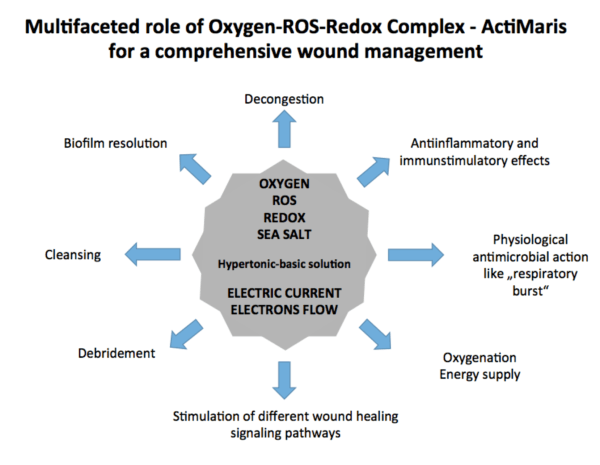
ACTIMARIS® COMPLEX – REDOX SIGNALING THERAPEUTIC AGENT FOR THE TREATMENT OF INFLAMMATORY AND INFECTIOUS PROCESSES ON THE SKIN AND MUCOUS MEMBRANE IN THE ENT REGION
Damir Marincic, MD
Quorum Medis Center, (St.Gallen, SWITZERLAND)
Background and Aims
The aim of the clinical study was to compare the effectiveness of treatment with a new bioactive REDOX signaling therapeutic agent as local monotherapy (on the cell-biophysical basis) with standardized, therapeutic procedures for the treatment of inflammatory and infectious processes of the skin and mucous membrane in the ENT region.
Method
During 2 years 417 ambulant and hospitalized patients were included in this clinical study distributed according to diagnosis within 5 treatment groups. 61 of them (14.5%) were randomized left-right at otitis externa and rhino group and evaluated under application of 4 subjective and objective parameters including acoustic rhinometry. Study design was a prospective randomized controlled split-face study, partly compered with historical controls and partly randomized in the ActiMaris® liquid and gel group and “standard” treatment group. We evaluated the zero-hypothesis statistically with F-Test (likelihood-quotient).
Results
Altogether 417 patients have been included and statistically analyzed in this study. We consider in this report only 61 randomized cases. The zero-hypothesis could be rejected and alternative-hypothesis confirmed with 95% significance (p <= 0.05). Otitis group with ActiMaris® shows rapid reduction of pain, better and quickly decongestion and faster reduction of inflammatory signs. Rhino group shows objectively, with acoustic rhinometry, beside subjective parameters faster decongestion of endonasal mucousa.
Conclusions
Local monotherapy with the new bioactive REDOX signaling therapeutic agent revealed itself to be more successful and superior, without adverse effects, and also more cost-benefit effect in the treatment of inflammatory and infectious processes in the ENT region compared with previous “standard” procedures.
